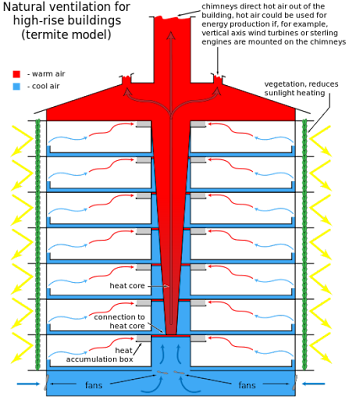Posts
Showing posts from September, 2023
Understanding the Impact of Low Delta-T on Chillers: Efficiency, Energy Consumption, and Maintenance Challenges
- Get link
- X
- Other Apps
.png)
In HVAC systems, the "Delta-T phenomenon" with respect to chillers typically refers to the difference in temperature (Delta-T) between the chilled water supply and return as it relates to the performance of the chiller unit. This phenomenon can affect the efficiency and effectiveness of the chiller system. Here are some key points: 1. Delta-T Variations : If the Delta-T is lower than expected, it may indicate that the chiller is not removing heat from the chilled water as efficiently as it should. This can result from issues such as fouled heat exchangers, low refrigerant levels, or improper chiller operation. 2. Efficiency Concerns :A reduced Delta-T can lead to decreased chiller efficiency, as the chiller may have to work harder to achieve the desired cooling effect. This can result in higher energy consumption and operational costs. 3. Monitoring and Optimization : HVAC professionals often monitor Delta-T closely as part of routine chiller maintenance. They may adjust sys...
A Breath of Fresh Air: Demystifying HVAC Calculations
- Get link
- X
- Other Apps

A Breath of Fresh Air: Demystifying HVAC Calculations Introduction Have you ever wondered what goes on behind the scenes to keep your home or workplace at a comfortable temperature year-round? The answer lies in the complex world of Heating, Ventilation, and Air Conditioning (HVAC) systems. HVAC calculations are at the heart of designing, installing, and maintaining these systems, ensuring they provide the right balance of comfort and efficiency. In this blog, we'll delve into the fascinating world of HVAC calculations and explore how they shape the environments we live and work in. Understanding HVAC Calculations 1. Load Calculation: - HVAC engineers begin by determining the heating and cooling load of a building. This load is the amount of heat that must be added or removed to maintain the desired indoor temperature. Load calculation factors in variables like the building's size, insulation, number of occupants, appliances, and outdoor climate conditions. - T...
The Limitations of Evaporative Cooling: Not Suitable for All Weather Conditions
- Get link
- X
- Other Apps

The Limitations of Evaporative Cooling: Not Suitable for All Weather Conditions Introduction Evaporative cooling is an energy-efficient and environmentally friendly method of cooling spaces. It relies on the natural process of water evaporation to lower the temperature of the air. While this technology has gained popularity for its cost-effectiveness and sustainability, it's essential to understand that it is not suitable for all weather conditions. In this blog, we will explore the limitations of evaporative cooling and when it may not be the best choice. 1. High Humidity One of the most significant limitations of evaporative cooling is its ineffectiveness in high-humidity environments. Evaporative coolers work by drawing warm air through water-saturated pads, causing the water to evaporate and cool the air. However, when the air is already saturated with moisture, as is often the case in humid climates, there is limited room for additional water vapor. As a result, the cooling ef...
How We Market HVAC Products & Services
- Get link
- X
- Other Apps

How We Market HVAC Products & Services Our Comprehensive Strategy: 1. **Engaging Blog Posts:** Our content creators will craft informative and engaging blog posts that showcase the unique features and benefits of your HVAC products. These posts will not only drive organic traffic to your website but also position your brand as an industry authority. 2. **Captivating Vlogs:** Visual content is key in today's marketing landscape. We will produce vlogs that highlight your products in action, providing viewers with a firsthand look at their functionality and performance. These vlogs will be shared across various platforms, including YouTube and social media. 3. **Targeted Email Campaigns:** We will design and execute email campaigns that target your existing customer base and potential clients. These campaigns will include product updates, special offers, and educational content to keep your audience engaged and informed. 4. **Engrossing Podcasts:** We will colla...
The Power of Robotic Process Automation (RPA) & how I use it in my HVAC Business.
- Get link
- X
- Other Apps

The Power of Robotic Process Automation (RPA) & how I use it in my HVAC Business. In today's fast-paced and competitive business landscape, organizations are constantly seeking ways to streamline their operations, reduce costs, and improve efficiency. One technological innovation that has been gaining significant attention and adoption is Robotic Process Automation, or RPA. This transformative technology has the potential to revolutionize the way businesses operate, and in this blog, we will explore what RPA is, its benefits, and its impact on various industries. What is RPA? Robotic Process Automation (RPA) is a cutting-edge technology that uses software robots or "bots" to automate repetitive, rule-based tasks within business processes. These bots are designed to mimic human actions and interactions with digital systems, allowing them to perform tasks such as data entry, data extraction, report generation, and more, without human intervention. The Benefits of RPA 1....
- Get link
- X
- Other Apps

The Importance of Ventilation: A Breath of Fresh Air for Health and Comfort Introduction Ventilation is a fundamental aspect of our indoor environments that often goes unnoticed. However, it plays a crucial role in maintaining air quality, regulating temperature and humidity, and ensuring the comfort and well-being of occupants. In this comprehensive blog, we will explore the significance of ventilation, its various types, benefits, and best practices for implementation in residential and commercial spaces. Understanding Ventilation Ventilation is the process of exchanging indoor air with outdoor air to remove pollutants, control temperature and humidity, and provide fresh air for breathing. This exchange can occur naturally through windows and doors or be mechanically controlled through HVAC (Heating, Ventilation, and Air Conditioning) systems. Check HVAC BOOKS Types of Ventilation 1. Natural Ventilation: Natural ventilation relies on the principles of airflow driven...